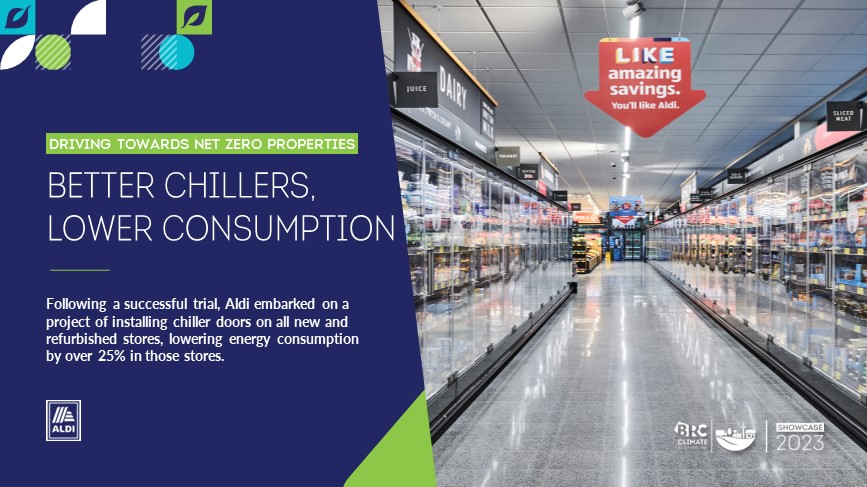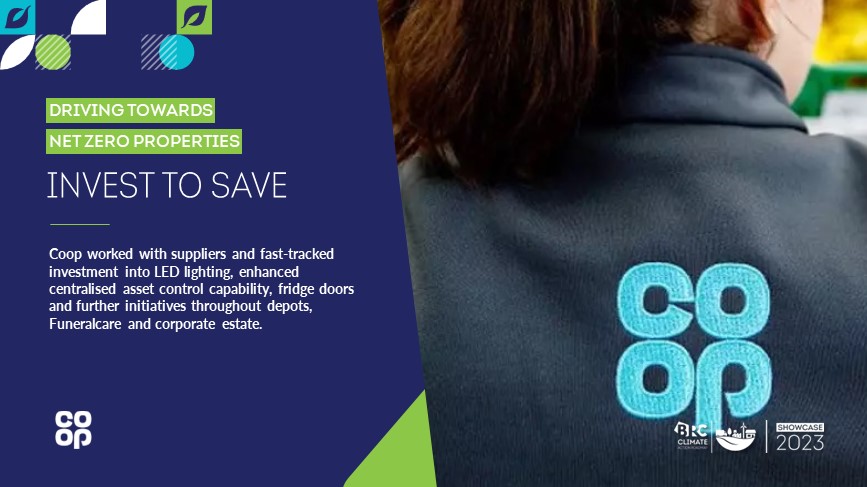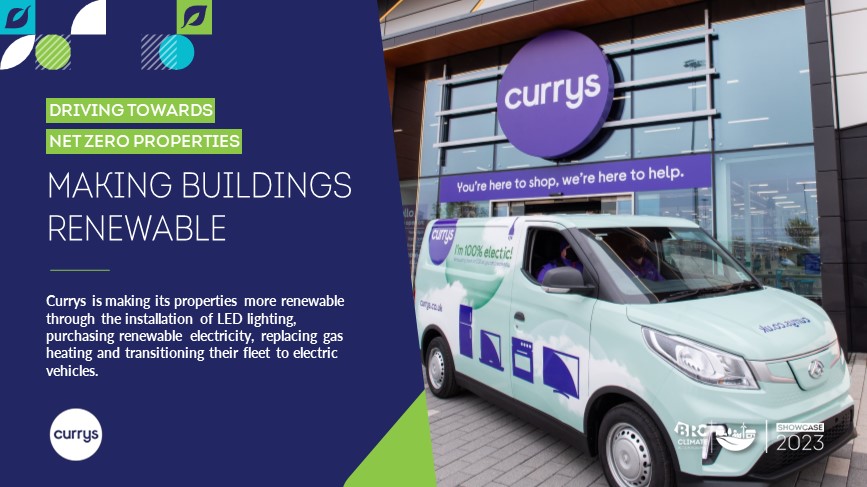Climate Action Roadmap Showcase | Tackling emissions in the supply chain | Reducing emissions in transport and logistics | Reducing Waste | Changing consumer behaviour
Driving towards Net Zero property
All physical premises have an associated energy demand, primarily for lighting, space heating and – where needed – cooling and refrigeration. They are also an area that are generally under full or partial control of the retailer, and actions that reduce the operating carbon footprint can provide operational cost savings. This category is about investing in or making changes to premises (including shops, offices and warehouses) which improve their sustainability performance. For example, the use of LEDs or low carbon refrigerants, investing in low/zero carbon heat networks and insulation, or installing solar panels and other net zero energy generation.
aldi uk

LEARN MORE
Aldi was looking for a solution to improve energy efficiency of its Store estate to:
The supermarket, which has been carbon neutral since January 2019, has already reduced its carbon footprint by more than 61% since 2012 through a number of sustainability initiatives, including the use of solar panels, switching to 100% green electricity and investing in a greener fleet.
Refrigeration is Aldi’s biggest energy user in Stores and therefore presents a big opportunity to achieve the business’ goals. The change followed a successful trial from 2017 to 2020, reducing each store’s energy consumption by approximately 20%, equivalent to a carbon emission saving of up to 20 tonnes per store each year.
Currently c. 200 Stores have chiller doors installed. They are helping Aldi to keep chilled food and fresh produce cold more efficiently, saving 160,000 kWh of electricity per Store each year. That’s equivalent to taking 5,371 tonnes of Co2 (tCO2e) out of the electricity grid annually.
central co-op
co-op

LEARN MORE
Co-operating to be Energy Smart
Co-op has long been committed to reducing its energy consumption and direct greenhouse gas emissions, measuring and reporting our carbon footprint since 2006. At the end of 2021, we hit our short term target to halve our direct emissions three years early.
The invasion of Ukraine by Russia had acute consequences and demanded a radical rethink. With senior executive support to be brave, work in new ways, and break down traditional siloes, the challenge was set: how would we reduce energy consumption and operational greenhouse gas emissions at extreme pace? A brand new, multi-disciplinary team was born to develop and implement a new programme:
Co-operating to be Energy Smart.
In under eight months, 1,800 energy audits were conducted in a huge and unprecedented effort to identify as many energy saving initiatives as possible. A huge volume of ideas (some new, many that under normal assumptions would have been deemed too risky) were turned into successful energy reduction initiatives. At the heart of our decision making has been data, informing what we should target, measuring whether initiatives have saved energy and costs, and for the first time utilising customer and colleague feedback to establish in real time where adjustments to our approach were needed.
The results speak for themselves. Each year from 2016 to 2021 we reduced our energy consumption by 5% p/a, but as a result of Co-operating to be Energy Smart the rate of this reduction has doubled to to 10% p/a.
Since the middle of 2022, we have successfully implemented, measured, and verified over 22,000 new energy saving measures.
Our total energy reduction is on track by the end of 2023 to reach c55 GWh: the equivalent to powering around 18,500 average UK households for a whole year – or over 11,000 tCO2e saved.
Currys

LEARN MORE
Currys has a role to play in addressing climate change and sustainability. In the UK and Ireland we operate over 300 stores with a footprint of over 5.5 million square feet. Taken together with our contact centres, warehousing and distribution centres and offices, a considerable proportion of our Scope 1 and 2 GHG emissions derive from real estate.
In response to this we are continuing to take action to reduce our use of energy through the rollout of LED lighting, the optimisation of our building management system control for heating ventilation and air conditioning (‘HVAC’) systems and reducing lighting with various trials and improved reporting of consumption and monitoring.
100% of our properties in the UK are powered by renewable electricity. We also have four UK sites with Solar PV installed, with a capacity of over 2MWp, reducing our emissions by approximately 303 tonnes of CO2e.
In line with the British Retail Consortium’s Climate Action Roadmap, we have set a target to operate 100% LED coverage in all new buildings by 2025 – we made progress in 2022/23 and now 85% of our UK and Ireland portfolio uses LED technology as the main source of lighting – well on track to meet the BRC milestone for 100% LEDs in all buildings by 2035. In the UK and Ireland, Building Management System optimisation of HVAC systems reduced the energy used in 187 stores with an electricity saving of 3,521,755kWh.
We have started a programme to replace gas heating with heat pumps in a number of retail store locations which remain gas heated.
We actively engage our colleagues, our customers and our partners (including our landlords) in the road to net zero.
ikea

LEARN MORE
The IKEA commitment to become climate positive and a circular business by 2030 saw us take significant action. We built on the legacy of COP26 in Glasgow with high-level, global knowledge sharing; engaged our 12,000 co-workers and the many people on affordable and sustainable solutions; made our sustainability data and insights available to all co-workers with the ability to scenario plan; we introduced ground-breaking energy saving technology to our stores; we reached our goal to cut our food waste by 50% vs 2017; and we launched a national competition to engage the next generation in sustainability (Let’s Go Zero campaign partner led by the charity Ashden). Perhaps most importantly in these times, we enhanced our People & Planet Positive product range and solutions and shared our life at home knowledge to enable and inspire customers live healthier and more sustainable lives, while also saving them money in the home.
IKEA has a clear climate strategy to 2030, taking responsibility for our own emissions without the use of offsets and inline with the Paris Agreement. We received our climate positive SBTi accreditation in 2018. We are committed to doing our part, by taking a full value chain approach, working towards becoming climate positive and securing a just transition.
We recognise the importance of setting credible targets in line with science and to understand their consequences. We are on the journey to: